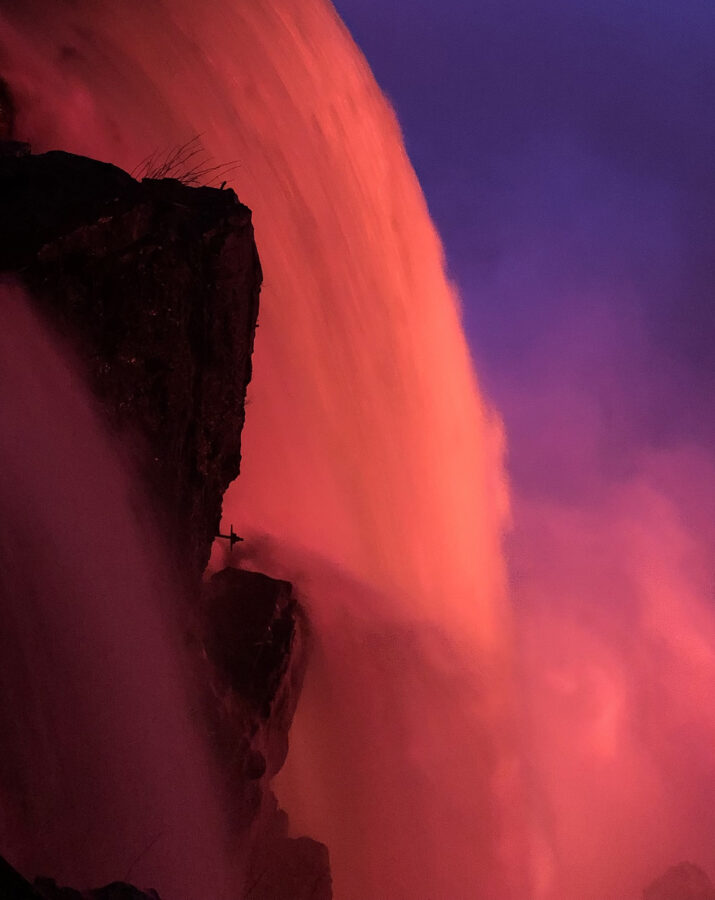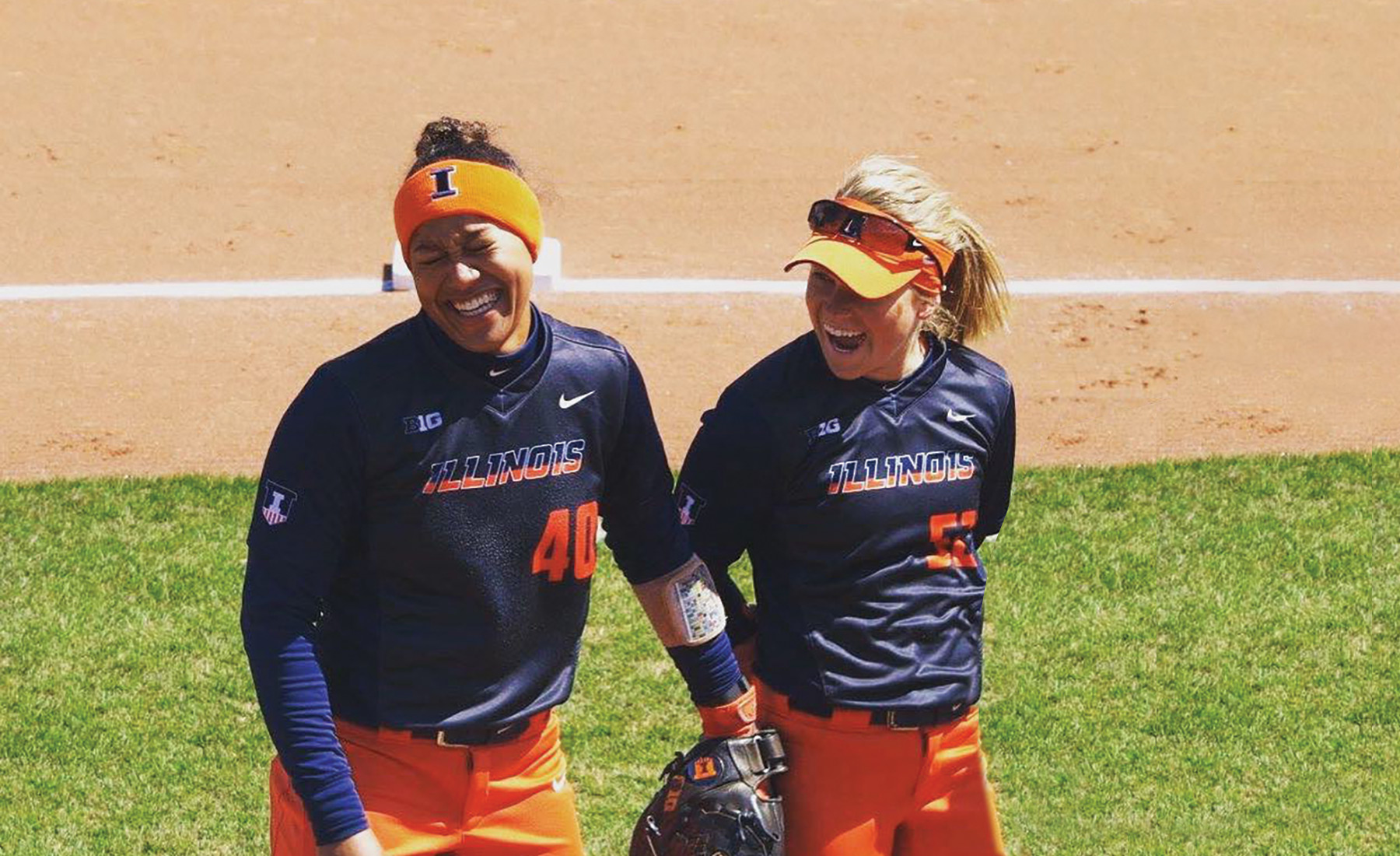With more than 700,000 gallons of water careening over a near-180-foot drop each second, Niagara Falls is a sight to behold—and that’s before you witness it illuminated in Illini orange and blue.
Thanks to Illinois alumnus Mark Thomas, who recently retired as director of the park, our school colors were on full display when Professor Michael Raycraft and his bus full of twenty-four Recreation, Sport, and Tourism (RST) students arrived at the Falls this past May.
It was day three in RST 180’s annual twelve-day tour of discipline-related locations throughout the Eastern United States.
Oftentimes, college programs organize short field trips to nearby sites or offer semester-long opportunities abroad. But a domestic tour jam-packed with more than twenty excursions in less than two weeks’ time?
“I’ve not heard of a trip of this type being offered by any other university,” says Raycraft.
Now in its third year, the course is part of the RST curriculum at Illinois, where students learn how to deliver a variety of leisure experiences to different populations. This can include anything from managing a professional sports team to running a historical museum to overseeing a state park facility.
“What we focus on at Illinois, which is unique, is, ‘What is it that people are motivated by?’” Raycraft explains. “If I can understand what people are motivated by for their leisure experiences, then I can shape a really interesting sports event, rec activity, or tourism destination.”
A culmination of everything learned in the classroom, RST 180’s end-of-the-semester trip is a chance for students to immerse themselves in each experience to better understand why they connect with people on a personal level. It’s also an opportunity to meet professionals in the field and explore potential career options.
It’s been dubbed the “Hall of Fame Tour,” and for good reason. This year’s list of stops featured a total of four—the Rock and Roll Hall of Fame, the National Baseball Hall of Fame, the National Museum of Racing and Hall of Fame, and the Pro Football Hall of Fame.
In addition to Niagara Falls, other highlights included Gettysburg Battlefield and Saratoga Springs, Flight 93 National Memorial, Progressive Field and First Energy Stadium (home to the Cleveland Indians and Browns, respectively), the U.S. Olympic and Paralympic Training Center, NCAA Headquarters, and Indianapolis Motor Speedway.
Each location provides a different educational experience for the group, with discussions ranging from simple compare and contrast to complex dialogue on how a single event can alter life as we know it.
Many of the students hadn’t heard of Shanksville, Pennsylvania, for example, or why they would be stopping just outside of the two hundred-person town. But it happens to be the crash site of—and now a memorial to—Flight 93, the sole plane that never hit its intended target on 9/11 thanks to the forty individuals aboard the aircraft.

“The students this year were literally zero to two years old when that happened, so it really led to some interesting conversations about life-changing events that affect a whole culture,” says Raycraft. “There are good things that happen and bad things that happen, but we all have those moments in time where we are changed by them. We had an opportunity to reflect on that.”
Other lessons the class learns firsthand are practical in application, such as how to bring in revenue during an off-season (“You’ve got a ski resort … well, how are you going to make money in July?”) or the importance of crafting RST experiences accessible to everyone. This need for inclusivity is even more apparent when some students themselves are unable to take part in certain activities.
“When you travel with someone who’s in a wheelchair, if you’ve never done that before, you think about things differently,” says Raycraft. “These are things you have to think about, especially if you’re getting into this type of industry. That’s part of it. You can’t just be thinking about your norm. This type of experience exposes you to everyone else’s norm, too.”
Most important, the class is given opportunities to interface with current industry leaders—including Illinois alumni like Thomas—along the way. Because the majority of students are freshmen, they gain an early understanding of the field and the many possibilities it holds career-wise.
“I think they come back with a much more informed appreciation for items related to rec, sport, and tourism industries. It’s not just, ‘Oh, we’re all going to be the general manager of the Cubs,’” Raycraft says. “There are so many different ways to approach it.”
The industry leaders sharing those approaches are happy to provide the class with a more holistic view. They give talks, offer tours, and take part in Q&A panels. They also go out of their way to make the experience special for the students.
For Thomas, that meant lighting up the Falls.
At Lake Placid, home to the 1980 Winter Olympics, the class’s tour guide recited Herb Brooks’ famous “Miracle on Ice” speech word for word in the same locker room it was originally given nearly forty years ago, when the United States hockey team managed a come-from-behind victory over undefeated Russia on its way to winning a gold medal.
“Oh, it was chilling,” says Raycraft. “It was absolutely chilling. We have this conversation about politics and sports and how all these things interact. This event directly impacted the Cold War. There’s mutual understanding and cultural things that happen in the world all collected at this one spot.”
At Indianapolis Motor Speedway, home of the Indy 500, Raycraft was even granted permission to drive his charter bus around the famed racetrack.
“The last thing we do is, we get our bus and we take a lap of the track and take a picture at the finish line of the Indy 500,” Raycraft says. “It’s kind of symbolic of a lot of things.”
The victory lap not only celebrates the personal and professional insights students glean over the course of the trip, but also the new connections they form as a result. In tradition with the Indy 500, where the winner always drinks milk, Raycraft bought each student a carton of the white stuff to top off the occasion.
“We bring in a collection of people who are completely diverse, completely different,” he says. “No one really knows anybody. They’re all from different walks of life, and they come back after a two-week session bonded.”
This bond should come as no surprise, especially for Raycraft’s students. After all, that’s exactly why, Raycraft explains, the RST industry is so important:
“It’s something that connects people and generations and cultures. There are things we can all get behind, and it’s something that brings people together.”
This story also appears in, Journeys, a website dedicated to Illinois’ Office of Undergraduate Admissions.
This story was published .







